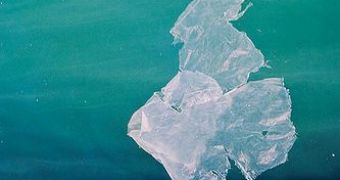A lone plastic bag was spotted floating 600 kilometers southeast of Canada, over the final resting place of what was once the biggest tragedy in history, the RMS Titanic.
Oceanographer David Gall of the Woods Hole Oceanographic Institution (WHOI) in Massachusetts, is in charge of a comprehensive survey of the Titanic site, first discovered by the WHOI almost 25 years ago.
While on his ship, he spotted this plastic bag, floating in the deep blue waters of the Atlantic, and remembered that humankind is building another huge tragedy, the pollution of the planet.
“I walked out on the deck to appreciate a calm blue sea and there it was, it was totally unexpected and it had a profound impact on those of us on deck,” said Gallo.
This lone plastic bag that has gotten so far off the coast land is an infinite small percentage of the garbage that is floating in the oceans, garbage that man created and then discarded in the marine world.
“We look at Titanic as the greatest disaster at sea, but the Titanic was a single tragic event, [and] what we are doing to the sea on an everyday basis is one of the great untold tragedies,” Gallo told OurAmazingPlanet, amazed that this piece of plastic traveled to the shipwreck site, 370 miles away from Newfoundland, Canada.
It must have been brought by the Gulf Stream - the strong, warm-water current that flows northward along the American East Coast, after starting its journey somewhere on or beyond the East Coast of the US.
Over the last 22 years, ships have found plastic pieces trapped in their long nets, pieces that probably have floated across hundreds of miles in the North Atlantic ocean.
In the middle of the Pacific Ocean lies the “Great Pacific Garbage Patch”, one of the most depressing areas in the world, with bits of plastic debris floating over hundreds of miles across.
In garbage patches, the plastic pieces are trapped in by circular ocean currents and mainly float on the surface of the water.
One problem is that sea birds take this plastic pieces for fish eggs and swallow them, and sea turtles sometimes swallow clear plastic bags because they look like jellyfish, according to data from the Environmental Protection Agency.
In time, another kind of pollution starts, as the ocean water breaks the plastic into microscopic particles that trap inside them pollutants like polychlorinated biphenyls, or PCBs.
These plastic particles are swallowed by small ocean animals that pass them up the food chain, and this way plastic accumulates inside the animals' bodies.
In 2008, Antarctic expeditions have found pieces of plastic floating in remote waters, plastic that could have come from ships at sea, from polluted coastal towns or from land-based garbage dumps.
“We are slowly turning the oceans into a chemical soup, and plastics are a big part of that,” said Gallo.
Humans are turning the Earth into a huge garbage dump and if we don't stop the pollution sometimes soon and start the cleaning process as well as a healthier way of life, than we will one day be inhabiting a dead planet.

 14 DAY TRIAL //
14 DAY TRIAL //